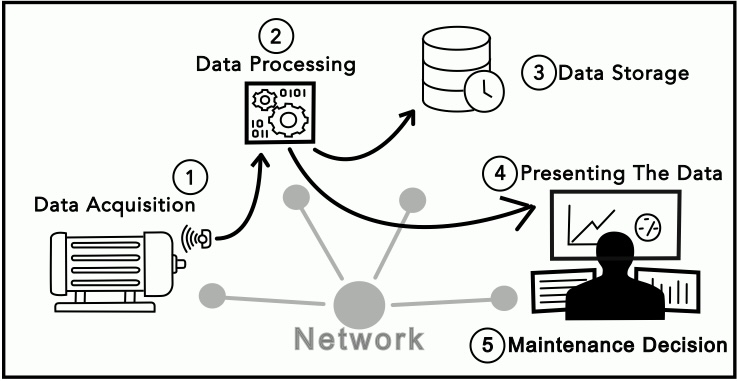Predictive maintenance provides operators with a reliable estimate of when maintenance will be needed on an industrial asset.
The 5 steps of predictive maintenance start with data acquisition. Then, data processing identifies whether a failure will occur in the near future. Finally, the processed data is stored and visualized for operators to analyze and make decisions.
5 Steps of Predictive Maintenance
The network that connects all of these steps, moves the data from one step to the next. Lets take a more detailed look at each of these steps.
Video: How Predictive Maintenance Works
1. Data Acquisition
Good data is the foundation for reliable models and predictions. The most common data types used for predictive maintenance are vibration and infrared but any measurement that changes with the condition of the asset makes a good data source.
Acquiring the data from these sensors requires them to be connected. Sensors connect by wire when the cost of that is affordable. Another option is Industrial wireless infrastructure from sensor manufacturers like Emerson and Honeywell. Both have robust industrial wireless solutions that typically cost less than installing network cables.
2. Data Processing
Raw data is rarely meaningful by itself, so data processing is an important step to convert the raw data into meaningful information. In some cases this is done by normalizing the data and comparing it to a predetermined threshold. In other cases the outcomes can only be determined by combining multiple data sources in a model that’s been developed through machine learning or some other analysis.
Some solutions process the data at the edge near the asset being monitored in what’s called edge processing. Other solutions process the data in a centralized IoT platform, in the data center or in a cloud service.
3. Data Storage
After processing the data, the next step can be presenting the data for action. In parallel with that action step, data is usually stored for future analysis. Analyzing the data over the long term and across multiple assets, improves the algorithms and predictive models being used. This approach also provides a broader view to trends across multiple assets and longer periods of time to identify systemic issues and resolve them at a big picture level.
4. Presenting the Data
Making the data actionable with a simple, visual interface can be the difference between high value action and having the information lost in the noise of daily data feeds. The delivery of simple actionable information builds trust over time as it reliably predicts failure scenarios. In the best systems, these simple action steps expand into more data that can be examined for a detailed explanation.
The more advanced systems combine the individual sensor analysis with a knowledge base using artificial intelligence. From this broader data set the system recommends clear actions and in some cases also creates a service ticket for an operator to review. Cisco uses this approach for the maintenance of network infrastructure assets and similar approaches also work for industrial environments.
5. Maintenance Decision Making
In the final step operators act on the recommendations of the predictive maintenance system. For simple systems the operator draws from their domain knowledge to identify which maintenance activities to schedule. In the more advanced artificial intelligence example the system identifies the recommended activities and the operator validates the recommendation and authorizes the action.
In summary, the 5 steps of predictive maintenance reliably estimate the time that maintenance will be needed on a specific industrial asset. Data from sensors on the asset travels securely across the network, processing it, storing it and presenting it along the way. Ultimately, an operator making the maintenance decision, establishes a more efficient and productive maintenance practise.
Related Information
Predictive Maintenance platform examples:
AVEVA Predictive Analytics
Emerson Prediction Software
Honeywell Asset Reliability System
Industrial Network – Cisco Validated Designs

This article was helpful. How is an industrial wireless system cheaper than running cables? Also what differs from an off the shelf wireless solution compared to the industrial wireless solutions you mentioned? Our current infrastructure doesn’t allow us to practically lay down wires so we are exploring our options. Thank you.
I’m glad to hear this article was helpful. Your experience of cabling not being practical is not unique. Installing cable is often quite expensive and it can be very disruptive. That is a big reason wireless is less expensive. Industrial wireless like Emerson or Honeywell has better latency, reliability and resiliency characteristics than wifi. We partner with them so wifi endpoints can connect through us and industrial endpoints can connect through them.